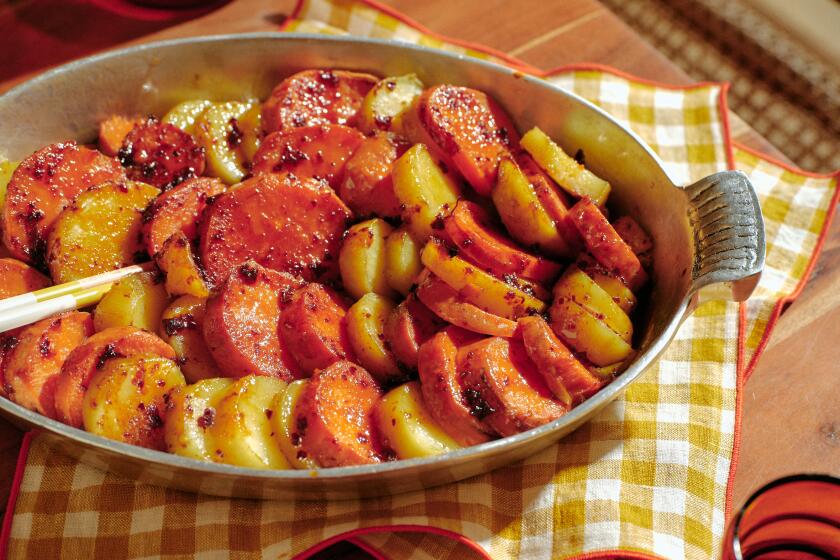Basic white asparagus
- Share via
A springtime menu in Germany, Alsace, Austria or Switzerland may read as follows: white asparagus with smoked salmon, white asparagus with new potatoes, white asparagus with veal in morel sauce. The spargelkarte (white asparagus menu) always lists the white asparagus first, as the star attraction, while such glamorous foods such as lobster, veal and salmon are relegated to secondary roles, mere supporting actors.
What is it that gives this slender star its cult-like status? These rare white stalks have been regarded as delicacies for more than 2,000 years. As early as 200 BC, the Romans had how-to-grow instructions for white asparagus. They enjoyed it in season and were the first to preserve it by freezing: In the 1st century, fast chariots and runners took asparagus from the Tiber River area to the snowline of the Alps, where it was kept. Roman emperors maintained special asparagus fleets to gather and carry the choicest spears to the empire. The characteristics of asparagus were so well known that Emperor Caesar Augustus defined “haste” to his underlings as “quicker than you can cook asparagus.”
For Europeans today, white asparagus is celebrated not only for its rich, creamy, delicate flavor but also because it signifies the arrival of spring--warmer weather, sunshine, lighter clothes and lighter cuisine. Out with stew, cassoulet and choucroute garni. In with steamed white asparagus accompanying just about anything you can think of.
In German towns like Schliengen, where I’m from, the transformation seems to happen almost overnight. I remember going to bed one night and waking up the next morning to find Frischer Spargeln (fresh white asparagus) signs set proudly in front of every restaurant, a seemingly spontaneous act of defiant collusion as we shed ourselves of winter and ushered in the long-awaited spring.
The laborious effort of harvesting white asparagus begins daily at 5:30 a.m. It must be done in early morning or at the day’s end to avoid exposure to the sun, which would turn the asparagus green.
The long stretches of dirt mounds are covered with black plastic sheets, which prevent the white asparagus from developing chlorophyll and create a warming hothouse effect to encourage earlier readiness for harvest. When the plastic is removed, little cracks in the surface of the mounds give harvesters a hint of the asparagus’ whereabouts. Each individual stalk is partially dug free by hand before workers use special long-handled knives to cut them from the ground. Special care must be taken not to disturb other, unseen, stalks that are not yet ready to be picked.
The holes are then covered with the loose dirt and patted smooth with trowels in preparation for the next day’s harvest. Folklore has it that, at the height of the season, under perfect conditions, one can literally watch white asparagus grow.
The fields are used solely for white asparagus, which is harvested only from early April until the summer solstice in late June, after which, it is said, the fields must be allowed to rest for the next year’s production.
This backbreaking work, coupled with the relatively short season, makes white asparagus one of the most expensive vegetables on the market. It also explains why only the head chef or a trusted sous-chef is allowed to peel it. If it’s not peeled deeply enough, the asparagus can be stringy. If too much is peeled, you may be throwing away hundreds of dollars.
To peel white asparagus, start about one inch from the head and stroke downward to the end of the stalk, keeping the pressure constant. This is done gently all around the stalk, while taking care to support the spear so as not to break it. The shavings are then used for stock to make asparagus soup.
Steamed or blanched in water well-seasoned with salt, lemon juice, butter and a bit of sugar, the carefully peeled stalks of white asparagus reveal a burst of earthy, sweet and slightly bitter flavors, similar to what we have grown to love in vegetables such as radicchio, endive or arugula. Germans even have a word to describe this kind of flavor-edelbitter, which means a refined, good bitterness (it is also used to describe chocolate).
White asparagus’ texture is soft and creamy, with a slight stringiness and a silky weight. At its best, it reveals a profusion of buttery, earthy, nutty, juicy flavors that is best served plain or with such simple accompaniments as boiled new potatoes, smoked salmon, chopped boiled eggs, smoky Black Forest ham or morel mushrooms.
But even more than flavor, the arrival of white asparagus season symbolizes, for many Europeans, something of a small victory. It ushers out the dark, gray, cold winter season and sets the stage for a bountiful harvest of fruits and vegetables that extends clear into early winter, when the late-harvest Riesling grapes are picked. No other vegetable has that kind of an effect.
Rockenwagner is chef-owner of Rockenwagner restaurant in Santa Monica.
Bring the water to a simmer in a large pot with the salt, lemon juice, butter and sugar.
Meanwhile, trim about 1/2 inch from the ends of the asparagus. Lay the spears on a work surface and peel them with a sharp vegetable peeler, starting about 1 1/2 inches from the top and running evenly down the length of each spear. (Spears are brittle and can snap when peeled in midair.) Gather the spears into 2 to 4 bundles and tie them loosely with kitchen string, then lower them into the simmering water.
Cook, increasing the heat to maintain a simmer, if necessary, until the asparagus is tender when pierced with the tip of a knife, anywhere between 8 and 30 minutes, depending on the thickness of the spears. Lift the bundles from the water with kitchen tongs and drain them on paper towels.
Get our Cooking newsletter
Get a taste of Los Angeles — and the world — with recipes and kitchen tricks from the L.A. Times’ Cooking newsletter.
You may occasionally receive promotional content from the Los Angeles Times.















